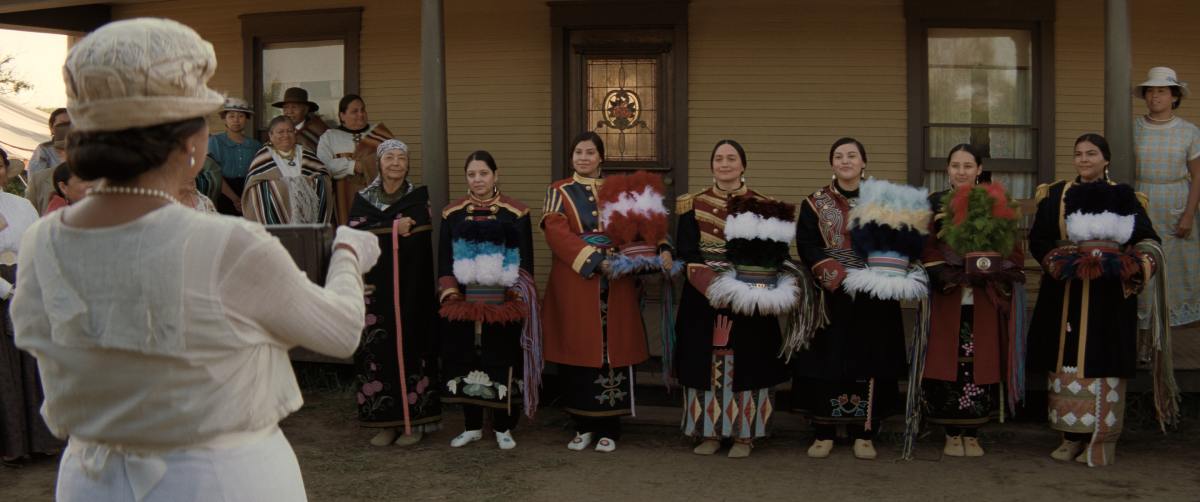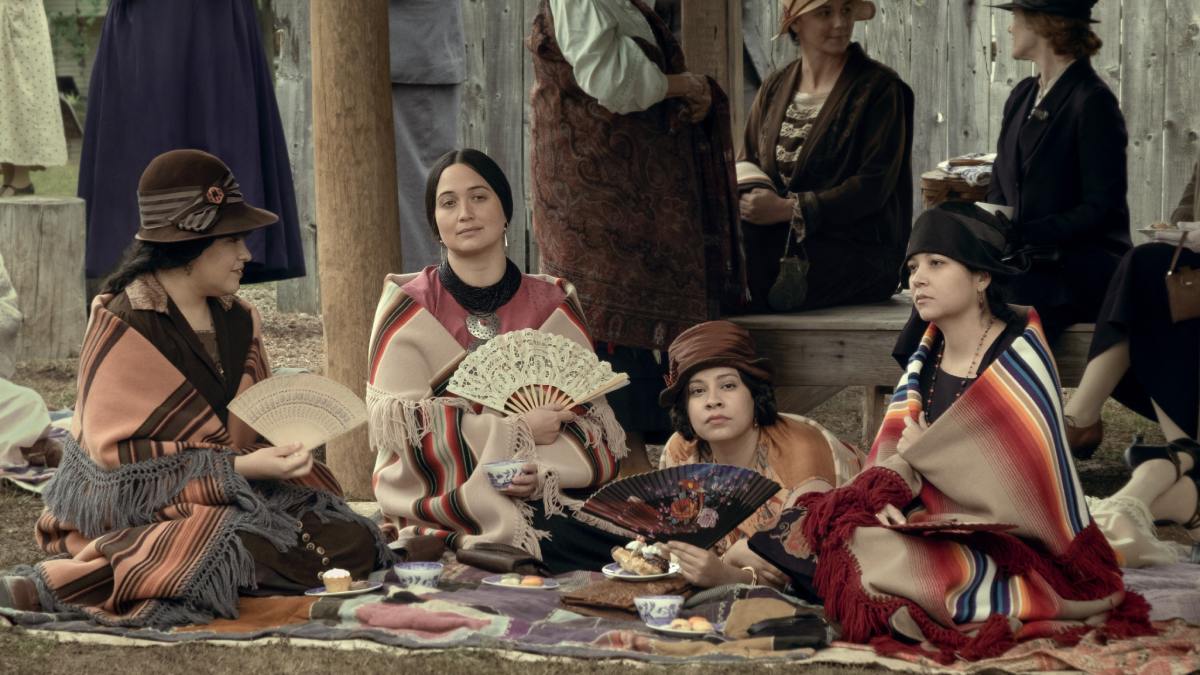The journey to the big screen of Đất Rừng Phương Nam and Killers of the Flower Moon is pretty similar.
Similar to Nguyễn Quang Dũng’s recent movie, Martin Scorsese’s latest film, released on October 20th, has been closely examined and discussed by the public. Since the news broke about its adaptation from a novel, people have had various opinions, all expressing the desire for an accurate portrayal of history and culture.
But what does “true” or “right” mean in adapting a story, like in the case of Killers of the Flower Moon? This film tells the story of the 1920s murders of Osage Nation members after oil was discovered on their land. Can cinema be accurate in telling this tale?
Vietcetera spoke with two Native Americans to discuss these questions. They are:
- Shea Vassar of the Cherokee Nation. She is a writer, journalist, and producer and was in the 2022 class of The National Center’s Native American 40 Under 40. Her works can be seen on RogerEbert.com, Slate, and Film School Rejects.
- Jim Gray of the Osage Nation. He is a consultant on tribal governments and a former Chief (2002 to 2010). His great-grandfather is Henry Roan, one of the victims during the “Reign of Terror” (as played by actor William Belleau in the film).
Where appropriate, we will also quote:
- Christopher Cote of the Osage Nation. He is one of the film’s Osage language consultants (who was present at the film’s Hollywood premiere on October 17).
- Martin Scorsese. He is the film’s director and co-writer (who was present at the press conference for the international press on October 16).
This interview has been lightly edited and condensed for clarity.
Why should Native Americans have a role in the media about their culture?
Gray: I was once the publisher of the Native American Times about 25 years ago. For years, we did reviews of movies at the time, so I was pretty aware that a lot more needed to be done to get indigenous representation in the industry.
[As for Killers of the Flower Moon,] firstly, the Osage already knew this story. Until the book came out in 2017, this was largely forgotten in history by the public. We didn’t go looking for attention; the attention came to us.
Once the book was going to be made into a major motion picture, we reached out to Scorsese to offer our perspective, one that may not be in the FBI files that were the source material for the book and movie. Things like our culture, way of life, language, clothing, and what an Osage home looked like were then incorporated.
[In a series of tweets made in May, Gray said Scorsese privately met with descendants to “hear our concerns,” which led to script revisions afterward.]

Vassar: I first realized the need for better representation of Native communities and really all Indigenous peoples when I was in film school in New York City. I had just started a freelance career in film criticism, and I realized just how white and male-dominated the entertainment journalism world was. This was 2016. [Then], Wind River’s release, along with the #MeToo movement, raised some vital questions about systematic changes. It took me years before I actually sat down to watch the film. I couldn’t believe the marketing focused on the two white leads.
Then, I realized that it wasn’t just a marketing choice. The movie really only focuses on two white people despite the violent assault and murder that a Native woman goes through.
Scorsese: [While co-writing the script with Eric Roth,] I wanted to keep balancing with the Osage. It was getting bigger and bigger and more diffused. And ultimately, this was supplemented by the times that we went out to Oklahoma and met with the Osage. My first meeting was with Chief Standing Bear and his group: Julie and Addie Roanhorse and Chad Renfro. It was very different from what I expected.
They were naturally cautious. I had to explain to them, and I’m just gonna try and deal with them as honestly and truthfully as possible. We weren’t going to fall into the trap. We think of the cliché of victims, or the drunken Indian, or all of this sort of thing, and yet tell the story as [straightforwardly] as possible.
What I didn’t really understand [before] the first couple of meetings was that this is an ongoing situation, an ongoing story out in Oklahoma… The people involved are still there, meaning the families are still there, and the descendants are still there.

Can we find a balance between ‘creative liberty’ and ‘historical accuracy’?
Gray: Well, [Killers of the Flower Moon] is not a documentary; it’s a movie based on actual events. We all had to manage expectations. But, for the most part, the consultants did an excellent job in capturing the essence of Osage culture to add authenticity to the film’s depiction of Osage life in the 1920s.
Vassar: I believe that historical and cultural accuracy can exist in cinematic storytelling, but I think the intention that is brought in by the director and producers really is what makes the difference. Is an executive just trying to tell a sensational story that will grasp the attention of the true-crime trend? Or is there a want for the victims of these true events to be humanized? Obviously, there is a ton of gray area, and because modern Native representation is such a new thing, this is an ongoing and developing conversation.
Ultimately, this story is the Osage community’s story to tell. But anyone who works in or knows the entertainment industry understands that a project of this level and with this budget is reserved for a select few filmmakers.
The fact that the director was open to listening and creating a dialogue with the film’s consultants is great … but this should not be a rarity — especially when the subject matter is true events, true traumas with current descendants who are available to offer their perspective.

Scorsese: In some cases, there was wiggle room because, quite honestly, I think the last two generations of Osage forgot about or were taken out of their experience because they had to become, like, white Europeans. They had to become, you know, Christians, Catholics, whatever. So they forgot about all that. They were all learning again to put their culture back together through this movie.
And we were going with them, so if this person puts the blanket on this way, and the baby-naming is that [way?], one person would say, “Maybe yes.” Another would say, “Maybe no.” Another one would say, “You have a little room here to play with it and have some creative license.” So, that’s the way we did it throughout.
Did switching from the BOI investigator to the Burkhart household ruin the source material?
Vassar: I think that Martin Scorsese is a legend for many reasons. He is the guy who is known for showing the dirty, ugly side of greed and masculinity. That’s why it makes sense that this filmmaker, this artist, who is used to deconstructing some of these systems, would tell a different story than the book David Grann would tell.
The source material is more of a deep dive into what happened, but it does favor the narrative that the Osage murders that were being committed in the 1920s led to more policing. But we, as Native people, know the creation of something like the FBI did not solve any of the systematic racism that was at play in these strategically planned murders.
If anything, I think Scorsese’s choice was the correct one, but I also believe that was because of the Osage people who came forward and made sure that they were involved in the storytelling.
Gray: Had [Scorsese] kept the script around the FBI, the Osages would have been secondary characters in their own story. This change elevated Mollie, the Osage woman at the center of this sinister murder-for-money drama. This crime was as intimate as it gets.
Scorsese’s willingness to adapt the film to include Osage perspectives was remarkable considering the $200 million budget. His changes — I think it helped make this film better.

Cote: I think that’s because this film isn’t made for an Osage audience. It was made for everybody, not Osage.
Those who have been disenfranchised can relate, but for other countries that have their acts and their history of oppression, this is an opportunity for them to ask themselves this question of morality, and that’s how I feel about this film.
Scorsese: …[Roth and I] started reworking the script, and it became gritty. Instead of from the outside in, coming in and finding out who’s done it, you know, when in reality it’s who didn’t do it. It’s a story of complicity. It’s a story of sin by omission. Silent complicity in certain cases. That’s what afforded us the opportunity to open the picture up and start from the inside out.
…What I wanted to capture, ultimately, was the very nature of the virus or the cancer that creates this sense of a kind of easygoing genocide. And that’s why we went with the story with Mollie and Ernest because that’s the basis of the love. The love is the basis of trust, so when there’s betrayal, [it’s] way, way deep.
What is the ‘ideal’ way to handle historical inaccuracies?
Gray: I would like for Indigenous people to be more in control of the project. But short of that, you would want active participation by the Indigenous people throughout the process in front of and behind the camera.
Not every Indigenous film project is going to have a “Martin Scorsese” direct it, but you can learn from Killers of the Flower Moon to follow a similar process of collaboration … You must first establish trust and a process that includes the people you are making a film about. Once that happens, the story might evolve into one that may not be the original idea, but quite possibly a better one as it reflects the voices and vision of the [culture being depicted].

Vassar: The best way is to center the voices and perspectives of those that the film or television show is representing. Since Killers of a Flower Moon has come out, I’ve enjoyed seeing the various levels of insight different Osage people have put out via social media or even in articles. And while this film is going to elicit opinions from more than just Osage viewers, it should be their personal perspective that is the loudest … I’ve had others remind me of this, and I have to remind myself of this since Native people here in North America are not a monolith.
Those who want to discuss or broadcast their opinions regarding a film like Killers of a Flower Moon should just expect to hold space for differing views. Really, this should be the ultimate guideline for any sort of art or cultural criticism.
Cote: As an Osage, I really wanted this to be from the perspective of Mollie and what her family experienced, but I think it would take an Osage to do that.
Scorsese, not being Osage, I think he did a great job representing our people, but this history is being told almost from the perspective of Ernest Burkhart. And they kind of give him this conscience and kind of depict that there’s love. But when somebody conspired to murder your entire family, that’s not love. That’s not love; that’s just beyond abuse.
